Instruction
The A Swing: A simpler way to swing

As a golf instructor, you are always trying to improve your knowledge and understanding of the golf swing in order to help your students improve the efficiency of their swing as well as their ball striking consistency. No matter the player’s talent level, I’ve also come to understand how important it is to keep the approach of improving a player’s action as simple as possible.
During my 20+ year association with David Leadbetter and our elite worldwide Leadbetter teaching staff, we are consistently pushing the limits on how to simplify the complex game of golf. It’s a teaching culture within the Leadbetter organization inspired by David himself, and is fully captured in his new book “The A Swing.”
The A Swing is very much an evolution of David’s teaching philosophy, and emphasizes the synchronization between the three key fundamentals of the swing:
- Setup
- Body turn
- Club swing
What sets the A Swing approach apart is how simple it is for any player to understand, feel, and ultimately execute. Since first discussing and implementing some of the A Swing concepts with David in 2012, we have seen some dramatic improvements at every level with our players. Lydia Ko, the world’s No. 1-ranked female golfer, has been working with David and I since the Fall of 2013 has many A Swing traits that blend perfectly with her effortless swing rhythm.
Traditional Backswing
A Swing Backswing
The whole essence of the A Swing is based on synchronization. To me, synchronizing the swing’s two main components — torso rotation and the arm/club action — is paramount in good ball striking, regardless of the philosophy one follows.
In most cases in the golf swing, poor body motion is directly related to arms, hands and a club that are out of position. This can be observed if a player makes a simple pivot motion with their arms folded across their chest, where they would wind up going back, transition going forward, and then unwind to a balanced finish. More often than not, it looks technically correct. Yet take the same player and put a club in their hand, and the body motion looks totally different.
Related: Visit the A Swing Website
Watch the video below with Brett Meyer of the Leadbetter Golf Academy to see the incredible results of one student who worked with David on The A Swing.
The goal with the A Swing is to develop a powerful, balanced torso motion using ground force, and compliment it with a simple arm action. What we are suggesting is eliminating wasted motion with the hands and arms in order to create great synchronization going back and coming down. In our biomechanical testing, we have found that on average the butt of the club travels 20 percent less than a conventional, on-plane backswing. This savings is huge as far as synchronization is concerned, and really allows the arms/club and body to arrive at their destination at the top almost in tandem. It also encourages an in-sync downswing, and allows the body to work more effectively.
In all our testing with players of different levels, we have found the transfer of energy throughout the swing to be much more efficient. In many cases, we have seen not only improvement in accuracy (wouldn’t most players settle for that?), but also increased ball speed as a result of more center-face contact.
In addition to conceptualizing the A Swing approach, there are complimentary drills to help speed up the learning process to grasp this alternative backswing, thereby setting up a powerful, on-plane downswing. Depending on the needs of my clients, who typically struggle to find time to practice, I can implant a segment or a full compliment of the A Swing knowing that with minor changes, they will see immediate results.
It’s all about getting better and as an instructor it’s been great to see real improvement among our players of all ages and abilities with the A Swing.
- LIKE187
- LEGIT26
- WOW14
- LOL9
- IDHT9
- FLOP15
- OB10
- SHANK107
Instruction
The Wedge Guy: The easiest-to-learn golf basic

My golf learning began with this simple fact – if you don’t have a fundamentally sound hold on the golf club, it is practically impossible for your body to execute a fundamentally sound golf swing. I’m still a big believer that the golf swing is much easier to execute if you begin with the proper hold on the club.
As you might imagine, I come into contact with hundreds of golfers of all skill levels. And it is very rare to see a good player with a bad hold on the golf club. There are some exceptions, for sure, but they are very few and very far between, and they typically have beat so many balls with their poor grip that they’ve found a way to work around it.
The reality of biophysics is that the body moves only in certain ways – and the particulars of the way you hold the golf club can totally prevent a sound swing motion that allows the club to release properly through the impact zone. The wonderful thing is that anyone can learn how to put a fundamentally sound hold on the golf club, and you can practice it anywhere your hands are not otherwise engaged, like watching TV or just sitting and relaxing.
Whether you prefer an overlap, interlock or full-finger (not baseball!) grip on the club, the same fundamentals apply. Here are the major grip faults I see most often, in the order of the frequency:
Mis-aligned hands
By this I mean that the palms of the two hands are not parallel to each other. Too many golfers have a weak left hand and strong right, or vice versa. The easiest way to learn how to hold the club with your palms aligned properly is to grip a plain wooden ruler or yardstick. It forces the hands to align properly and shows you how that feels. If you grip and re-grip a yardstick several times, then grip a club, you’ll see that the learning curve is almost immediate.
The position of the grip in the upper/left hand
I also observe many golfers who have the butt of the grip too far into the heel pad of the upper hand (the left hand for right-handed players). It’s amazing how much easier it is to release the club through the ball if even 1/4-1/2″ of the butt is beyond the left heel pad. Try this yourself to see what I mean. Swing the club freely with just your left hand and notice the difference in its release from when you hold it at the end of the grip, versus gripping down even a half inch.
To help you really understand how this works, go to the range and hit shots with your five-iron gripped down a full inch to make the club the same length as your seven-iron. You will probably see an amazing shot shape difference, and likely not see as much distance loss as you would expect.
Too much lower (right) hand on the club
It seems like almost all golfers of 8-10 handicap or higher have the club too far into the palm of the lower hand, because that feels “good” if you are trying to control the path of the clubhead to the ball. But the golf swing is not an effort to hit at the ball – it is a swing of the club. The proper hold on the club has the grip underneath the pad at the base of the fingers. This will likely feel “weak” to you — like you cannot control the club like that. EXACTLY. You should not be trying to control the club with your lower/master hand.
Gripping too tightly
Nearly all golfers hold the club too tightly, which tenses up the forearms and prevents a proper release of the club through impact. In order for the club to move back and through properly, you must feel that the club is controlled by the last three fingers of the upper hand, and the middle two fingers of the lower hand. If you engage your thumbs and forefingers in “holding” the club, the result will almost always be a grip that is too tight. Try this for yourself. Hold the club in your upper hand only, and squeeze firmly with just the last three fingers, with the forefinger and thumb off the club entirely. You have good control, but your forearms are not tense. Then begin to squeeze down with your thumb and forefinger and observe the tensing of the entire forearm. This is the way we are made, so the key to preventing tenseness in the arms is to hold the club very lightly with the “pinchers” — the thumbs and forefingers.
So, those are what I believe are the four fundamentals of a good grip. Anyone can learn them in their home or office very quickly. There is no easier way to improve your ball striking consistency and add distance than giving more attention to the way you hold the golf club.
More from the Wedge Guy
- The Wedge Guy: Golf mastery begins with your wedge game
- The Wedge Guy: Why golf is 20 times harder than brain surgery
- The Wedge Guy: Musings on the golf ball rollback
- LIKE86
- LEGIT13
- WOW6
- LOL1
- IDHT0
- FLOP4
- OB1
- SHANK8
Instruction
Clement: Stop ripping off your swing with this drill!

Not the dreaded headcover under the armpit drill! As if your body is defective and can’t function by itself! Have you seen how incredible the human machine is with all the incredible feats of agility all kinds of athletes are accomplishing? You think your body is so defective (the good Lord is laughing his head off at you) that it needs a headcover tucked under the armpit so you can swing like T-Rex?
- LIKE0
- LEGIT2
- WOW2
- LOL0
- IDHT0
- FLOP0
- OB0
- SHANK2
Instruction
How a towel can fix your golf swing
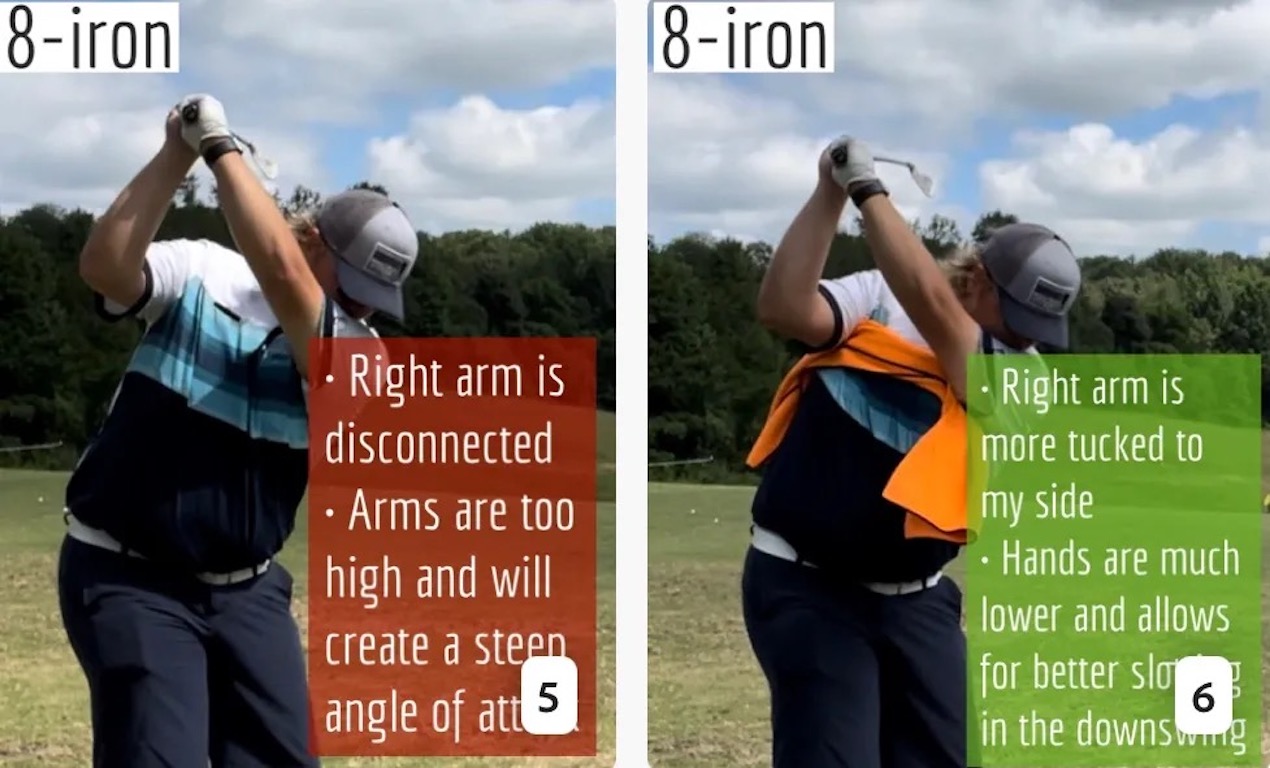
This is a classic drill that has been used for decades. However, the world of marketed training aids has grown so much during that time that this simple practice has been virtually forgotten. Because why teach people how to play golf using everyday items when you can create and sell a product that reinforces the same thing? Nevertheless, I am here to give you helpful advice without running to the nearest Edwin Watts or adding something to your Amazon cart.
For the “scoring clubs,” having a solid connection between the arms and body during the swing, especially through impact, is paramount to creating long-lasting consistency. And keeping that connection throughout the swing helps rotate the shoulders more to generate more power to help you hit it farther. So, how does this drill work, and what will your game benefit from it? Well, let’s get into it.
Setup
You can use this for basic chip shots up to complete swings. I use this with every club in my bag, up to a 9 or 8-iron. It’s natural to create incrementally more separation between the arms and body as you progress up the set. So doing this with a high iron or a wood is not recommended.
While you set up to hit a ball, simply tuck the towel underneath both armpits. The length of the towel will determine how tight it will be across your chest but don’t make it so loose that it gets in the way of your vision. After both sides are tucked, make some focused swings, keeping both arms firmly connected to the body during the backswing and follow through. (Note: It’s normal to lose connection on your lead arm during your finishing pose.) When you’re ready, put a ball in the way of those swings and get to work.
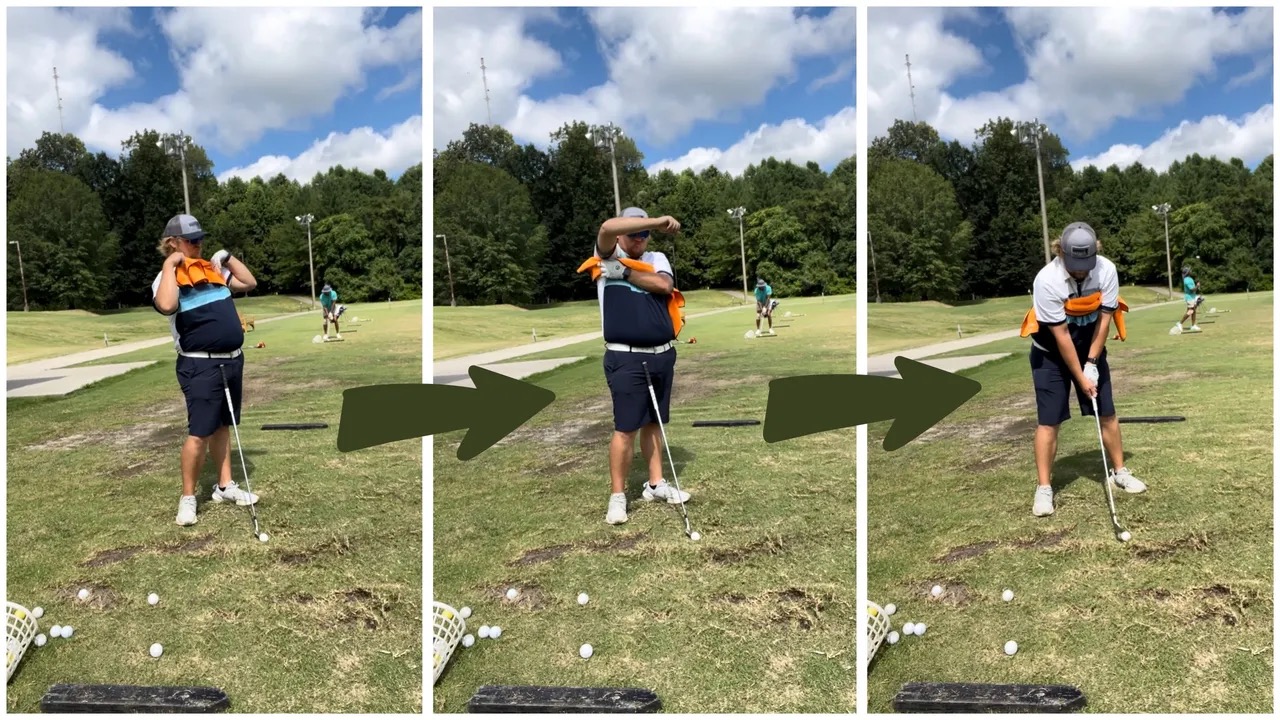
Get a Better Shoulder Turn
Many of us struggle to have proper shoulder rotation in our golf swing, especially during long layoffs. Making a swing that is all arms and no shoulders is a surefire way to have less control with wedges and less distance with full swings. Notice how I can get in a similar-looking position in both 60° wedge photos. However, one is weak and uncontrollable, while the other is strong and connected. One allows me to use my larger muscles to create my swing, and one doesn’t. The follow-through is another critical point where having a good connection, as well as solid shoulder rotation, is a must. This drill is great for those who tend to have a “chicken wing” form in their lead arm, which happens when it becomes separated from the body through impact.
In full swings, getting your shoulders to rotate in your golf swing is a great way to reinforce proper weight distribution. If your swing is all arms, it’s much harder to get your weight to naturally shift to the inside part of your trail foot in the backswing. Sure, you could make the mistake of “sliding” to get weight on your back foot, but that doesn’t fix the issue. You must turn into your trial leg to generate power. Additionally, look at the difference in separation between my hands and my head in the 8-iron examples. The green picture has more separation and has my hands lower. This will help me lessen my angle of attack and make it easier to hit the inside part of the golf ball, rather than the over-the-top move that the other picture produces.
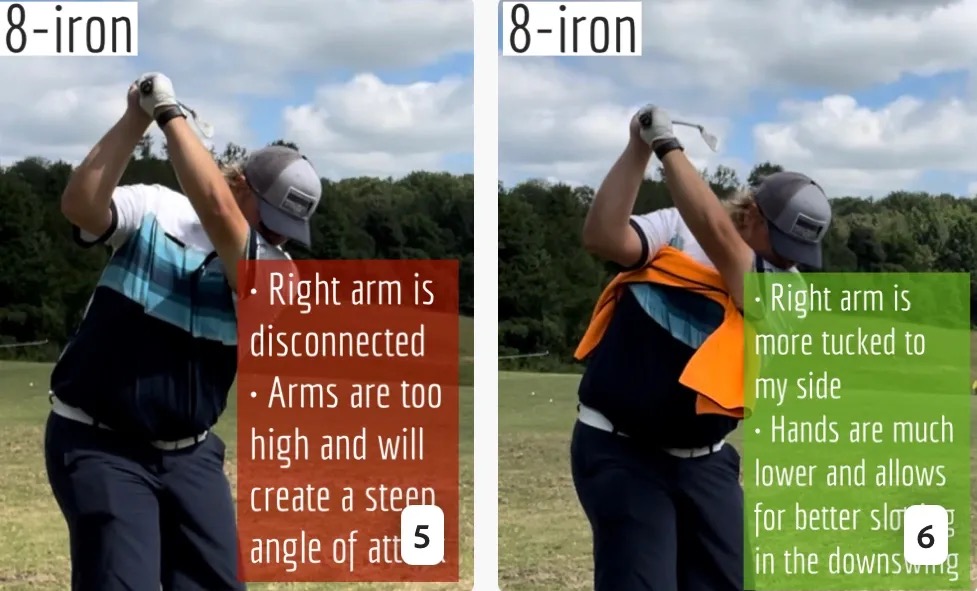
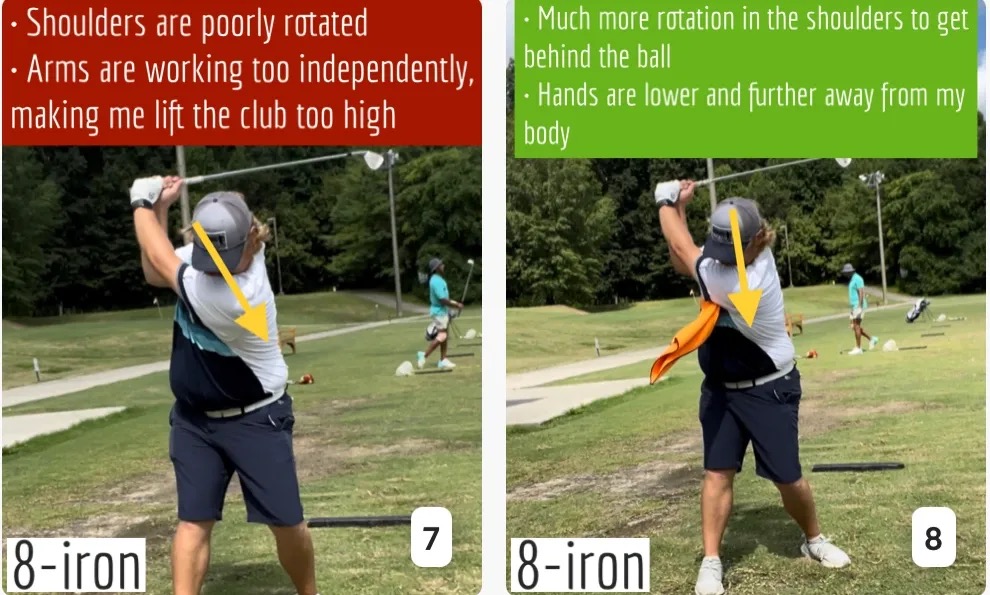
Stay Better Connected in the Backswing
When you don’t keep everything in your upper body working as one, getting to a good spot at the top of your swing is very hard to do. It would take impeccable timing along with great hand-eye coordination to hit quality shots with any sort of regularity if the arms are working separately from the body.
Notice in the red pictures of both my 60-degree wedge and 8-iron how high my hands are and the fact you can clearly see my shoulder through the gap in my arms. That has happened because the right arm, just above my elbow, has become totally disconnected from my body. That separation causes me to lift my hands as well as lose some of the extension in my left arm. This has been corrected in the green pictures by using this drill to reinforce that connection. It will also make you focus on keeping the lead arm close to your body as well. Because the moment either one loses that relationship, the towel falls.
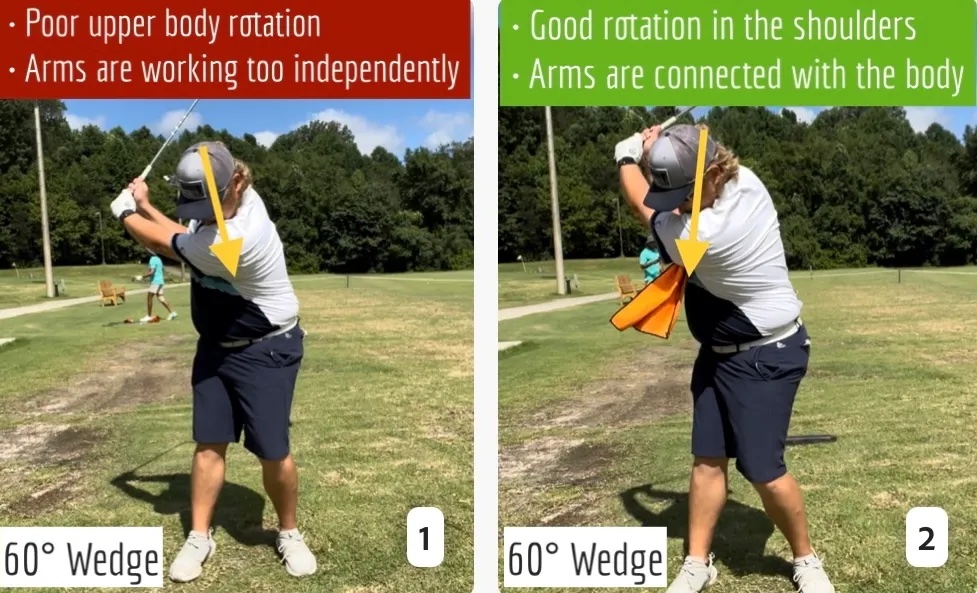
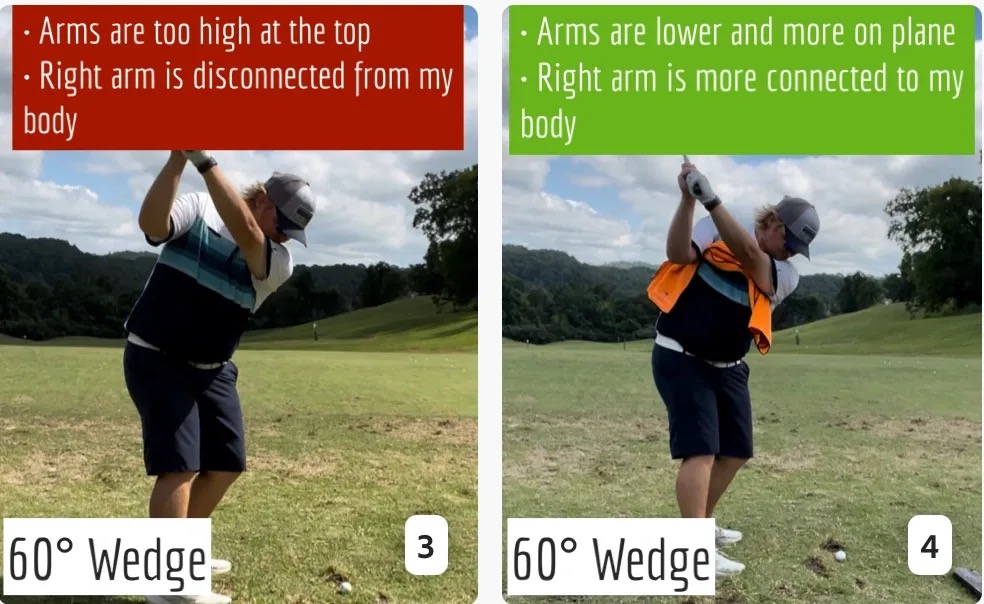
Conclusion
I have been diligent this year in finding a few drills that target some of the issues that plague my golf game; either by simply forgetting fundamental things or by coming to terms with the faults that have bitten me my whole career. I have found that having a few drills to fall back on to reinforce certain feelings helps me find my game a little easier, and the “towel drill” is most definitely one of them.
- LIKE12
- LEGIT2
- WOW2
- LOL0
- IDHT0
- FLOP2
- OB0
- SHANK8
-

 19th Hole1 week ago
19th Hole1 week agoDave Portnoy places monstrous outright bet for the 2024 Masters
-
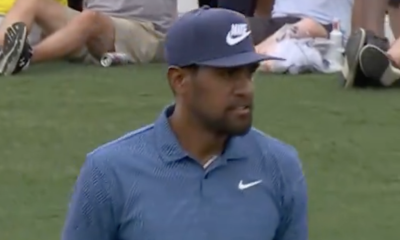
 19th Hole3 weeks ago
19th Hole3 weeks agoThings got heated at the Houston Open between Tony Finau and Alejandro Tosti. Here’s why
-

 19th Hole2 weeks ago
19th Hole2 weeks agoTiger Woods arrives at 2024 Masters equipped with a putter that may surprise you
-

 19th Hole2 weeks ago
19th Hole2 weeks agoReport: Tiger Woods has ‘eliminated sex’ in preparation for the 2024 Masters
-

 19th Hole6 days ago
19th Hole6 days agoTwo star names reportedly blanked Jon Rahm all week at the Masters
-

 19th Hole5 days ago
19th Hole5 days agoNeal Shipley presser ends in awkward fashion after reporter claims Tiger handed him note on 8th fairway
-

 19th Hole4 days ago
19th Hole4 days agoReport: LIV Golf identifies latest star name they hope to sign to breakaway tour
-

 19th Hole3 weeks ago
19th Hole3 weeks agoAddiction, spinal fusion, and scam artists – Everything Anthony Kim revealed in candid interview with David Feherty

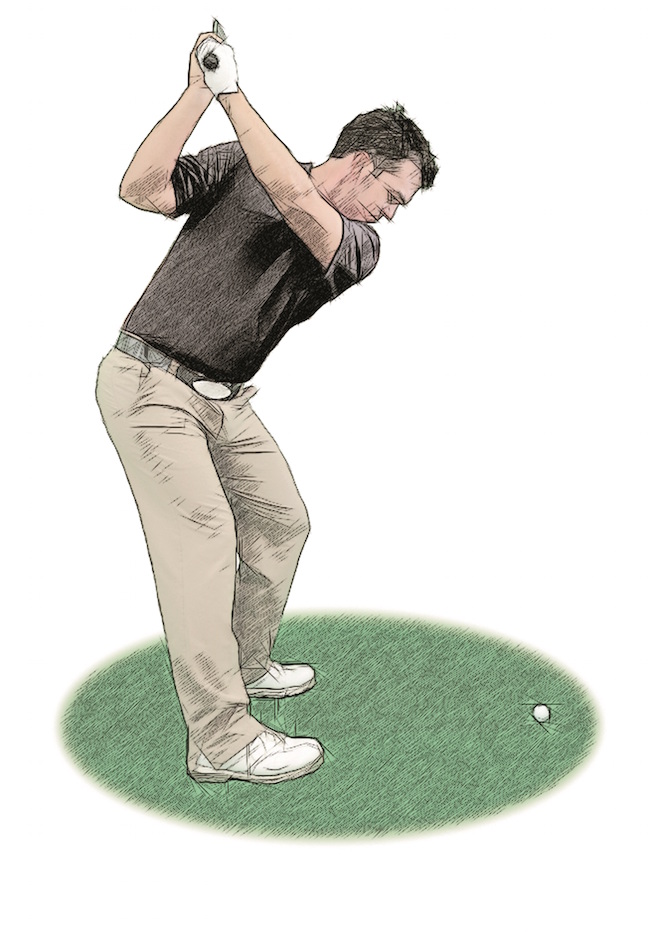
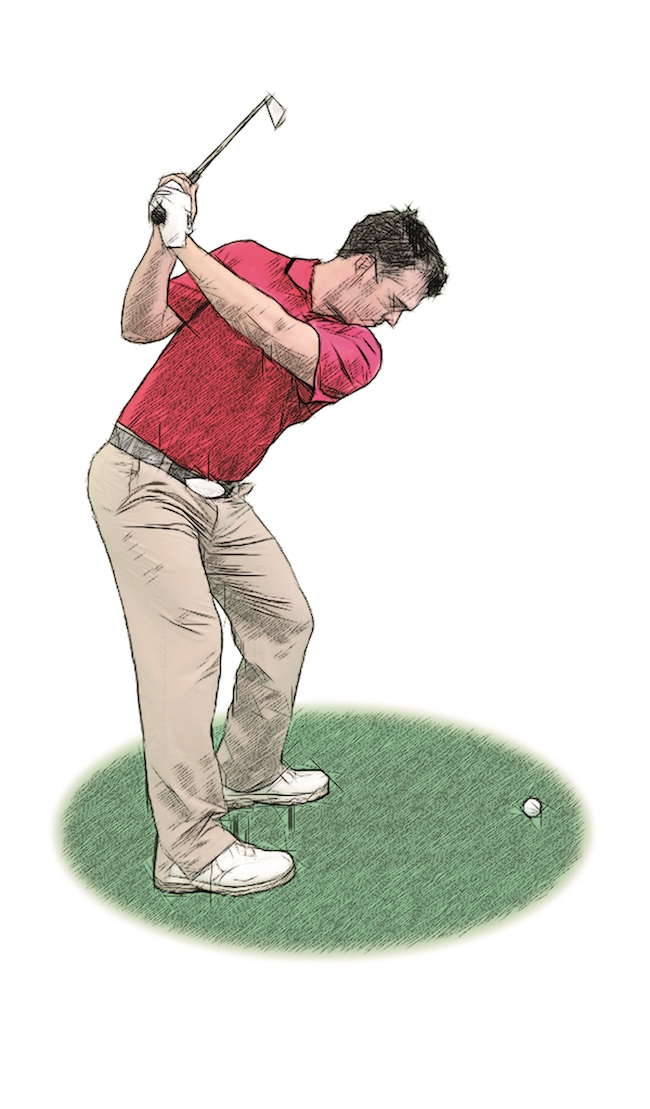







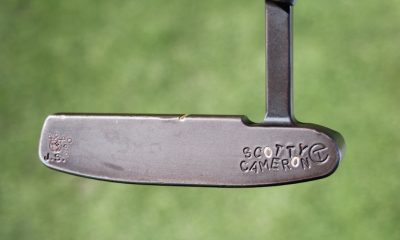





Bob J
Mar 10, 2017 at 1:28 am
Fascinating to read all the “gurus” here who know better than some of golf’s most accomplished teachers. LOL.
Ben B
May 5, 2016 at 12:48 am
I have never been a good golfer, and have never really believed in Leadbetter’s teaching. At 70 years old, I saw several videos on the A Swing, and without much practice, went to the driving range at a local course and hit about 10 balls with what I imagined the A Swing to be, and got called to first tee with my guys. Shot the best I had in years, and I am not good, mid 90’s, over the top. With his swing, I was less prone to come over the top due to the limited backswing alone.
Steve Wozeniak PGA
Sep 25, 2015 at 12:44 pm
I would have loved to be a fly on the wall when Lydia told these clowns to take this A swing and shove it………she tried it for a bit missed cuts and hit it like a dog, anyone that knows the golf swing laughs and this stuff…….Lydia is back swinging like Hogan, Ben that is!!!!!!
Anyone that has “written” 40 books about the golf swing is confused……
Tommy P
Jul 5, 2015 at 2:39 pm
I’m 82 and used to be a 10. Did not play for awhile and had trouble getting my swing back. Even before buying the book, just looking at the Utubes I was able to right away hit real good shots. You guys who are talking the swing down do not have the ability to follow directions.
Mike
Jun 22, 2015 at 9:49 am
Have not bought the book, just watched various videos to get the concept. Took what I perceived as the proper move to the range. Have to tell you there is something there ( for me at least) I am an 8 handicapper, always working on a new “move”. Don’t kid yourself, it takes some work to get it (at least for me it did). Probably have hit 1000 balls using the A swing. I am a believer. At least for me, I think there is something there. On the course by drives are longer, I am playing with guys a lot younger (I am 67) and I am up with them and past on occasions. I won the super seniors long drive contest last year at our State Match play with a 286 yard drive so I was not short to begin with. But my drives are more penetrating and I have a little draw I never had. So at least for me I will continue working on this technique.
Mike T
May 30, 2015 at 10:57 pm
A fully cupped wrist at the top? I’ve done that and it sucks big time. It’s all just to sell a new book? Bogus. They don’t even explain what the A in the A Swing is… I can think of one thing.
Susinto
May 29, 2015 at 5:34 am
Bought it 2 weeks ago, i didnt change all my swings to A swing, but it did enhance the “feel” part of my golf game. I was/am a very mechanical swinger., able to make me enhance the feel part of my swing, i give this book 10/10, also considering only 10% fee of local pro for 1 hour. Would recomend it to all my near kin, those wo want to pick up golf at full speed.
Video on youtube and limits of budget and also pros in my country – indonesia, doesnt help my game much. After reading this book on kindle, i now can hit my shot higher with more spin, higher flush shot percentange on my 6&5 iron, hybrid and 5 wood, with a few adjustment made.
According to me, the current world no.1 (yes Rory) has the same swing as the A swing. Look at the 1st part of upswing till the shaft is parallel to the ground. Its definitely A swing. More apparent on titleist Rory (less bulky Rory), than the nike Rory (muscleman Rory)
Cheers
gvogel
May 25, 2015 at 8:42 am
Two words: Jimmy Bruen.
Five words: Phil Rogers helicopter wedge swing.
Heli
May 25, 2015 at 10:57 am
Bernhard Langer helicopter too?
Tim
Jul 13, 2015 at 4:05 pm
I don’t see much video or read much about Phil Rodgers anymore, but he schooled Jack Nicklaus on the wedge game. Jack was never very good in that area (didn’t need to be compared to the rest of the field) but when he needed help he went to Phil. I still use his figure 8 flop shot a lot around the green-side rough.
Jayw
May 25, 2015 at 8:32 am
There is a huge improvement in the transition from the top of the back swing to down swing in the video on the right. In the left video the initial move that the golfer makes in the transition of the downswing is with his shoulders, hand, and arms, and immediately he starts the typical over the top casting. The club starts an outside-in club path and the ball flight is from left to right. In the video on the right, the golfer starts the downswing from the ground up. His transition starts with a drop of his hands and arms. At impact the club path is much more down the line to inside out. No casting whatsoever. This is absolutely a night and day difference.
joe
May 25, 2015 at 3:26 am
Is this not Jim Fury’s swing?
Flop
May 25, 2015 at 12:57 am
This is a total FLOP.
The guy in the video is simply getting a couple of basic, standard swing tips, just to straighten him out a little bit, because his usual, upright, steep swing is a bit over the top (pun intended) and can be easily fixed without all this A-swing bull sheet. And the new swing really isn’t that much of an improvement, as can be witnessed in the video, which is a terrible example of a video to show, by the way. If the student all of a sudden started hitting perfect little baby draws and his swing looked totally different to his original swing, I would have been impressed, but alas, as it stands now, it’s really just barely an improvement. F
Jayw
May 24, 2015 at 9:38 am
According to the book by Daniel Coyle, The Talent Code, Greatness isn’t born. It’s grown. There is no talent without hard work. Also, the most successful tour players think and talk positive. Everything that’s related to the game of golf is expensive. That’s the way it’s always been and most likely always will be. The A Swing by David Leadbetter is less than 20 bucks on Amazon. And ships free with prime. 1/2 dozen (6) top quality brand name golf balls cost about that much.
Joe
May 24, 2015 at 6:24 am
I’m an 8.5 hdcp. I like to tinker. I realize this “tinkering” may limit serious progress. That said, this A Swing has been enjoyable. The book (Kindle version) is a relatively quick read and there are plenty of videos on line to help with visuals. After just one range session, I would say it seems repeatable. To me, being one that doesn’t practice, that “repeatability” is important. I will definately continue with it….I hope I don’t get caught between swings and that my glutes fire.
JSteinmann
May 23, 2015 at 9:08 pm
Everyone has a gimmick to sell books and videos. Golf instruction is all about making money and selling hopes and dreams presented as secrets and shortcuts to replace what is simply talent and hard work.
MHendon
May 23, 2015 at 10:24 pm
Well said
Bob J
Mar 10, 2017 at 1:17 am
Hogwash
Jayw
May 23, 2015 at 7:54 am
I like what I see so far about the A Swing. It looks like a simple swing, and easy to maintain. I’m going to read the book to see if it’s for me or not. It’ll be a good read. I like learning about the golf swing. If I like it I’ll pursue it further, if not that’s ok, at the very least I will have additional knowledge. I was watching a Bobby Jones series on the golf channel one time an he said that insanity is doing the same thing over and over and expecting different results. In the A Swing video David was saying that the A swing is an Alternate method that may help some people that have difficulty with other swing types, etc. He made it clear that the A swing wasn’t for everyone or that it was not a cure all exact method. A lot of people have been using the conventional method for years and struggle with it and don’t improve. I don’t believe that the natural golf swing, or, single plane swing is the same as the A swing. Just to name a few of the differences that I see, in the single plane swing you spread your stance very wide, and place the ball more forward and out away from you so that you reach for the ball. Also, you rotate your hands and the clubhead on the backswing. I don’t see any of that in the A swing. The single plane is different and some like it. I always like to take a positive approach and take as much good out of something and someone as possible. I see only good things from A Swing that will help a lot of people that struggle with other swing types. Nothing ventured nothing gained.
Dudley Rogers
May 22, 2015 at 7:24 pm
It’s “…has been working with David and me…” not “with David and I”
other paul
May 22, 2015 at 7:21 pm
I am not sure what is with all the people on here calling it a shank. I think to many (not enough…?) people are reading Kelvin Miyahira’s stuff.
Jonny B
May 22, 2015 at 3:38 pm
Looks a lot like Ryan Moore’s swing.
MartyMoose
May 22, 2015 at 9:47 am
I’ll stick with the traditional backswing. The “A Swing” backswing has pull hook written all over it.
Guru
May 22, 2015 at 8:14 am
I hate that they tout this as revolutionary and try to add Lydia’s name to it.
The concept is simple. For those that are ‘hitters’ and not ‘swingers,’ you often put your lead arm on your chest at the top of the backswing, which gets your arms behind your chest in terms of sync and are too shallow coming into the ball, so trying to get the shaft parallel up top gets you out of whack. Come across the line to sync up. That is the A swing. Just saved you a ton of money.
Lydia is a swinger, and she does nothing close to the A swing. A hitters swing will always limit your distance vs a swingers swing, but is easier to learn IMO. Choose wisely and please don’t waste your money on these hacks
Bob J
Mar 10, 2017 at 1:23 am
Says the hack
ML
May 21, 2015 at 10:48 pm
Nearly impossible to make those changes In a couple “hours” by a 16 handicap
Couple years maybe
The guys a shill…. Now way
snowman
May 21, 2015 at 9:41 pm
This is very well may be a good way to teach/swing….But be on alert for the upcoming Ledbetter Infomercial/DVDs etc, etc that will hype this thing as “revolutionary” and all for three easy payments of 49.99. I love capitalism, and Ledbetter has stamped his name on lots of ‘golf stuff’ over the years.
Todd
May 21, 2015 at 7:12 pm
How do you determine when the body rotation and arm swing are “synchronized”? Can it be measured with a 3D motion measurement system? Is there a visual confirmation that can be gained from video? Seems awfully subjective to determine if there are no absolute tests for being “in sync”.
Desmond
May 21, 2015 at 4:26 pm
After watching the video, I do not see this “A Swing” as revolutionary only because I’ve seen much of it over the last 2 years. The backswing, with the left arm more against the chest, is what my instructor is teaching. It’s more forearms against the ribcage and lead arm more against chest, no need to separate, please quiet the hands and wrists (as most golfers move arms and wrists too much).I need to study this downswing more as more info is needed, but perhaps Leds took recent biomechanical studies, worked on it as other instructors I’ve read and visited, and voila! we have a “packaged” Alternative swing to which he can attract students. It’s a good gig, and better than “swing in the barrel Leds” of the ’90’s, which screwed up a lot of golfers with the spin move who took the barrell image literally.
What I’d like to see is the student on the left who was taught and videoed with Led’s traditional system, and then the same student on the right with the “A Swing.”
lance sedevie
May 21, 2015 at 3:39 pm
This pattern is the same as Brian Manzella’s soft draw pattern which works great and has been out for years. Nothing revolutionary to be seen here.
Anthony
May 21, 2015 at 3:27 pm
ok, so cross the line at the top? What about for us that do not slice the ball? in your traditional vs A swing picture, the traditional is right on plane at the top (traditionally speaking) and the A swing is crossing the line. Everything else being neutral, crossing the line at the top will get give the ball more draw/hook spin and reduce the slice. Crossing the line at the top taught to people who slice the ball, especially when they slice the ball because they are too laid off at the top. And the goal when teaching people to cross the line is that they move from their laid off move, to BEING ON PLANE, even though they feel they are crossing the line ( that is what is getting them on plane).
In the video you posted, before the lesson the guy is severely laid off at the top with an opened face (he is not on plane with a face square to the plane like in your traditional picture). After the lesson he looks like the traditional picture at the top of his swing(as he is on plane traditionally speaking), he is not crossing the line?
So is the A swing just telling you to get on plane at the top or cross the line? If it says to cross the line, he is not crossing the line at the top of his swing in this video. If A swing tells you to cross the line at the top, is that encouraged for someone who already hits draws?
Jake
May 21, 2015 at 11:58 am
This article seems like an advertisement for the book? Here’s some valueless fluff, now go buy my book. Poor.
Greg V
May 21, 2015 at 10:37 am
There are A swing videos by David Leadbetter on the current iPad Golf Digest edition.
My take is that the A swing is a shortened version of the type of outside/inside swing such as Jim Furyk makes. For many amateurs who fight a slice, over the top move, the A swing looks like it could provide positive benefits.
However, when you take a wonderfully natural swing which has worked at the highest level of women’s golf – Lydia Ko – and attempt to fit her action into the A swing paradigm, I believe that you are making a big mistake. My fear is that Lydia will start playing “golf swing”, instead of playing golf. That mistake has already been made by Michelle Wie and Suzanne Pettersen.
I hope that the effort to fit Lydia’s move into a “swing paradigm” is not the cause of Lydia’s recent substandard play, but I fear that it might be.
Jeff
May 21, 2015 at 9:49 am
Is this new swing motion basically a single plane swing with the club across the line or am I missing something. I’m curious because the photo of the A swing in the article looks exactly like my swing but as one plane swing and slightly across the line as I start down my hands track perfectly to the ball and the shaft flattens. All sounds good so far but the two problems are if the shaft flattens to long I can leave the face open with an inside path and if I try to square early I can get a little steep with an early release. It seems to me that this A Swing adds a bigger element of timing than if the shaft were on plane. Any suggestions Mr.Hogan.